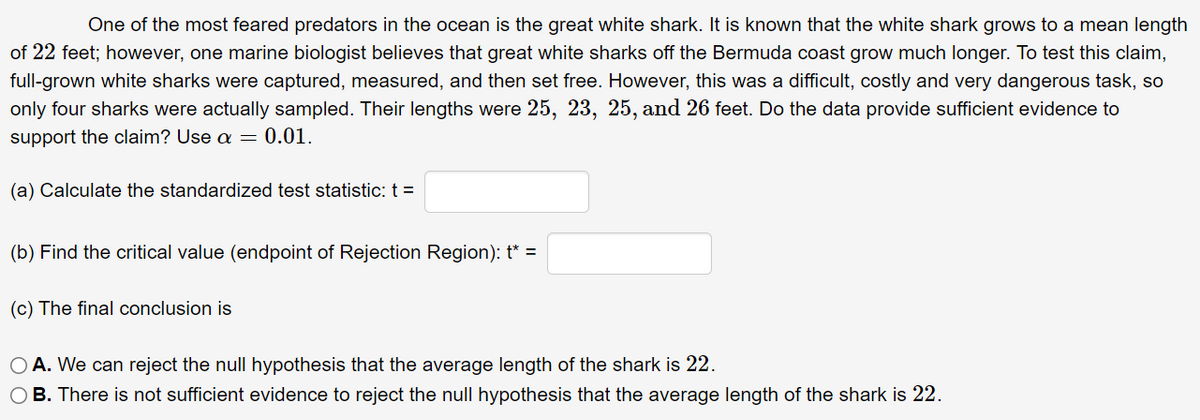One of the most feared predators in the ocean is the great white shark. It is known that the white shark grows to a mean length of 22 feet; however, one marine biologist believes that great white sharks off the Bermuda coast grow much longer. To test this claim, full-grown white sharks were captured, measured, and then set free. However, this was a difficult, costly and very dangerous task, so only four sharks were actually sampled. Their lengths were 25, 23, 25, and 26 feet. Do the data provide sufficient evidence to support the claim? Use a = 0.01. (a) Calculate the standardized test statistic: t = (b) Find the critical value (endpoint of Rejection Region): t* = (c) The final conclusion is O A. We can reject the null hypothesis that the average length of the shark is 22. OB. There is not sufficient evidence to reject the null hypothesis that the average length of the shark is 22.
One of the most feared predators in the ocean is the great white shark. It is known that the white shark grows to a mean length of 22 feet; however, one marine biologist believes that great white sharks off the Bermuda coast grow much longer. To test this claim, full-grown white sharks were captured, measured, and then set free. However, this was a difficult, costly and very dangerous task, so only four sharks were actually sampled. Their lengths were 25, 23, 25, and 26 feet. Do the data provide sufficient evidence to support the claim? Use a = 0.01. (a) Calculate the standardized test statistic: t = (b) Find the critical value (endpoint of Rejection Region): t* = (c) The final conclusion is O A. We can reject the null hypothesis that the average length of the shark is 22. OB. There is not sufficient evidence to reject the null hypothesis that the average length of the shark is 22.
Glencoe Algebra 1, Student Edition, 9780079039897, 0079039898, 2018
18th Edition
ISBN:9780079039897
Author:Carter
Publisher:Carter
Chapter10: Statistics
Section10.3: Measures Of Spread
Problem 2GP
Related questions
Topic Video
Question
100%

Transcribed Image Text:One of the most feared predators in the ocean is the great white shark. It is known that the white shark grows to a mean length
of 22 feet; however, one marine biologist believes that great white sharks off the Bermuda coast grow much longer. To test this claim,
full-grown white sharks were captured, measured, and then set free. However, this was a difficult, costly and very dangerous task, so
only four sharks were actually sampled. Their lengths were 25, 23, 25, and 26 feet. Do the data provide sufficient evidence to
support the claim? Use a = 0.01.
(a) Calculate the standardized test statistic: t =
(b) Find the critical value (endpoint of Rejection Region): t* =
(c) The final conclusion is
O A. We can reject the null hypothesis that the average length of the shark is 22.
O B. There is not sufficient evidence to reject the null hypothesis that the average length of the shark is 22.
Expert Solution
This question has been solved!
Explore an expertly crafted, step-by-step solution for a thorough understanding of key concepts.
This is a popular solution!
Trending now
This is a popular solution!
Step by step
Solved in 3 steps with 1 images

Knowledge Booster
Learn more about
Need a deep-dive on the concept behind this application? Look no further. Learn more about this topic, statistics and related others by exploring similar questions and additional content below.Recommended textbooks for you

Glencoe Algebra 1, Student Edition, 9780079039897…
Algebra
ISBN:
9780079039897
Author:
Carter
Publisher:
McGraw Hill

Holt Mcdougal Larson Pre-algebra: Student Edition…
Algebra
ISBN:
9780547587776
Author:
HOLT MCDOUGAL
Publisher:
HOLT MCDOUGAL

Glencoe Algebra 1, Student Edition, 9780079039897…
Algebra
ISBN:
9780079039897
Author:
Carter
Publisher:
McGraw Hill

Holt Mcdougal Larson Pre-algebra: Student Edition…
Algebra
ISBN:
9780547587776
Author:
HOLT MCDOUGAL
Publisher:
HOLT MCDOUGAL